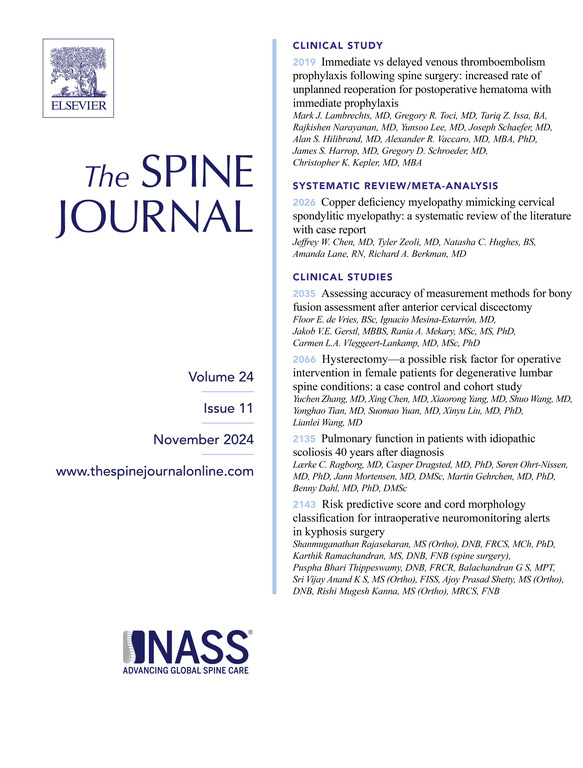Multirod posterior occipitocervical instrumentation constructs: a biomechanical analysis and initial case series of 10 patients with complex craniocervical pathology
IF 4.9
1区 医学
Q1 CLINICAL NEUROLOGY
引用次数: 0
Abstract
BACKGROUND CONTEXT
Stabilization of the occipitocervical (OC) junction with posterior instrumentation plays a vital role in addressing a spectrum of pathologies. Due to limited bone surfaces of the occiput and C1 lamina, achieving union across the OC junction is challenging.
PURPOSE
To explore the biomechanics and a clinical series of patients treated with multirod constructs across the OC junction using a novel occipital plate with single- and dual-headed, modular tulip heads.
STUDY DESIGN/SETTING
Biomechanical analysis and retrospective case series.
PATIENT SAMPLE
Adults at a single institution who underwent posterior cervical multirod constructs across the OC junction.
OUTCOME MEASURES
OC–C4 range of motion (ROM), maximum von Mises stress on the rods, and adjacent segment ROMs and intradiscal parameters. Patient demographics, revision operations, rod breakages, wound complications.
METHODS
A validated occiput-cervical finite element (FE) model was used to simulate OC–C4 cervical fixation under multidirectional pure moment loading. A total of 4 rod configurations were simulated: (A) 2-rod-Ti (4.0 mm titanium rods); (B) 2-rod-CoCr (3.5 mm cobalt chrome rods); (C) 3-rods (4.0 mm titanium rods); (D) 4-rods (4.0 mm titanium rods). The aforementioned measures were compared. A retrospective analysis was also performed of adults at a single institution who underwent posterior cervical multirod constructs across the OC junction.
RESULTS
Biomechanically, lowest primary rod stresses were observed for 3- and 4-rod constructs. Compared to 2-rod-Ti (121.8 MPa), 2-rod-CoCr showed a 43.2% stress increase in the rods, while 3- and 4-rods experienced rod stress reductions of 20% and 23.2%, respectively. No appreciable differences in OC–C4 ROM, C4–5 ROM, and C4–5 discal stresses were found between multirod and 2-rod constructs. Maximum occipital and C4 screw stresses were decreased in multirod constructs compared to 2-rods, with least stresses noted in the 4-rod construct. Maximum plate stresses were slightly increased in the 4-rod construct compared to 2- and 3-rod fixation, though the forces were largely similar among the constructs. Ten patients (average age 66.4±10.6 years; 8 males) were assessed clinically. Nine of the ten operations were for primary stabilization of pathological fractures and associated craniocervical and/or atlantoaxial instability using 4-rods across the OC junction. At an average follow-up time of 1.58±0.5 years (range, 1–2.3 years), there were no instrumentation failures, no adjacent segment failures, and no wound complications.
CONCLUSIONS
In this proof-of-concept investigation, multiple rods (3- and 4-rods) across the OC junction using a novel occipital plate with single- and dual-headed, modular tulips was safe and effective in stabilizing the OC junction. Accompanying FE analysis demonstrated that multirod constructs decreased primary rod stresses and had lower stresses on occipital and C4 screws compared to 2-rod constructs, while occipital plate stresses were largely similar. Additional clinical studies are needed to confirm these findings and to determine the ultimate utility of multirod constructs across the OC junction.
多杆式后枕颈椎器械结构:生物力学分析和 10 例复杂颅颈病变患者的初始病例系列。
背景情况:使用后路器械稳定枕颈(OC)交界处在治疗各种病症方面发挥着至关重要的作用。研究设计/设置:生物力学分析和回顾性病例系列:研究设计/设置:生物力学分析和回顾性病例系列:研究设计:生物力学分析和回顾性病例系列:结果测量:OC-C4活动范围(ROM)、杆上的最大von Mises应力、邻近节段ROM和椎间盘内参数。患者人口统计学、翻修手术、杆断裂、伤口并发症:方法:使用经过验证的枕颈部有限元(FE)模型模拟多方向纯力矩加载下的 OC-C4 颈椎固定。共模拟了 4 种杆件配置:(A) 2-杆-钛(4.0 毫米钛杆);(B) 2-杆-钴铬(3.5 毫米钴铬杆);(C) 3-杆(4.0 毫米钛杆);(D) 4-杆(4.0 毫米钛杆)。对上述措施进行了比较。此外,我们还对在一家机构接受颈椎后路多连杆横跨 OC 交界处构建的成人进行了回顾性分析:结果:从生物力学角度来看,3 根和 4 根连杆结构的主要连杆应力最低。与 2-连杆-钛(121.8 兆帕)相比,2-连杆-铬合金连杆的应力增加了 43.2%,而 3-连杆和 4-连杆的连杆应力分别降低了 20% 和 23.2%。多连杆和双连杆结构的 OC-C4 ROM、C4-5 ROM 和 C4-5 椎间盘应力没有明显差异。与双杆结构相比,多杆结构的枕骨和C4螺钉的最大应力有所降低,而4杆结构的应力最小。与双连杆和三连杆固定相比,四连杆结构的最大钢板应力略有增加,但各种结构的应力基本相似。临床评估了 10 名患者(平均年龄 66.4 ± 10.6 岁;8 名男性)。10 例手术中有 9 例是使用横跨 OC 交界处的 4 根连杆对病理性骨折和相关的颅颈和/或寰枢椎不稳进行初次稳定。平均随访时间为 1.58 ± 0.5 年(1 - 2.3 年),无器械故障、无邻近节段故障、无伤口并发症:在这项概念验证研究中,使用带有单头和双头模块化郁金香的新型枕骨板,将多根(3 根和 4 根)横跨 OC 交界处,可安全有效地稳定 OC 交界处。随附的 FE 分析表明,与双杆结构相比,多杆结构降低了主杆应力,降低了枕骨和 C4 螺钉的应力,而枕骨板应力则基本相似。还需要更多的临床研究来证实这些发现,并确定多杆结构在 OC 交界处的最终用途。
本文章由计算机程序翻译,如有差异,请以英文原文为准。
求助全文
约1分钟内获得全文
求助全文
来源期刊

Spine Journal
医学-临床神经学
CiteScore
8.20
自引率
6.70%
发文量
680
审稿时长
13.1 weeks
期刊介绍:
The Spine Journal, the official journal of the North American Spine Society, is an international and multidisciplinary journal that publishes original, peer-reviewed articles on research and treatment related to the spine and spine care, including basic science and clinical investigations. It is a condition of publication that manuscripts submitted to The Spine Journal have not been published, and will not be simultaneously submitted or published elsewhere. The Spine Journal also publishes major reviews of specific topics by acknowledged authorities, technical notes, teaching editorials, and other special features, Letters to the Editor-in-Chief are encouraged.
 求助内容:
求助内容: 应助结果提醒方式:
应助结果提醒方式:


